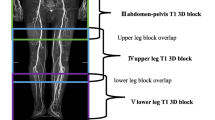Abstract
Objective
To investigate the feasibility of subtractionless first-pass single contrast medium dose (0.1 mmol/kg) peripheral magnetic resonance angiography (MRA) at 1.5 T using two-point Dixon fat suppression and compare it with conventional subtraction MRA in terms of image quality.
Methods
Twenty-eight patients (13 male, 15 female; mean age ± standard deviation, 66 ± 16 years) with known or suspected peripheral arterial disease underwent subtractionless and subtraction first-pass MRA at 1.5 T using two-point Dixon fat suppression. Results were compared with regard to vessel-to-background contrast. A phantom study was performed to assess the signal-to-noise ratio (SNR) of both MRA techniques. Two experienced observers scored subjective image quality. Agreement regarding subjective image quality was expressed in quadratic weighted κ values.
Results
Vessel-to-background contrast improved in all anatomical locations with the subtractionless method versus the subtraction method (all P < 0.001). Subjective image quality was uniformly higher with the subtractionless method (all P < 0.03, except for the aorto-iliac arteries for observer 1, P = 0.052). SNR was 15 % higher with the subtractionless method (31.9 vs 27.6).
Conclusion
This study demonstrates the feasibility of subtractionless first-pass single contrast medium dose lower extremity MRA. Moreover, both objective and subjective image quality are better than with subtraction MRA.
Key Points
• MRA is increasingly used for vascular applications.
• Dixon imaging offers an alternative to image subtraction for fat suppression.
• Subtractionless first-pass peripheral MRA is possible using two-point Dixon fat suppression.
• Subtractionless peripheral MRA is possible at 1.5 T a single contrast medium dose.
• Subtractionless first-pass peripheral MRA provides good image quality with few non-diagnostic studies.




Similar content being viewed by others
References
Leiner T, Kessels AGH, Nelemans PJ, Vasbinder GBC, de Haan MW, Kitslaar PEJHM et al (2005) Peripheral arterial disease: comparison of color duplex US and contrast-enhanced MR angiography for diagnosis. Radiology 235:699–708
Nelemans PJ, Leiner T, de Vet HC, van Engelshoven JM (2000) Peripheral arterial disease: meta-analysis of the diagnostic performance of MR angiography. Radiology 217:105–114
Koelemay MJ, Lijmer JG, Stoker J, Legemate DA, Bossuyt PM (2001) Magnetic resonance angiography for the evaluation of lower extremity arterial disease: a meta-analysis. JAMA 285:1338–1345
Menke J, Larsen J (2010) Meta-analysis: accuracy of contrast-enhanced magnetic resonance angiography for assessing steno-occlusions in peripheral arterial disease. Ann Intern Med 153:325–334
Ho KY, Leiner T, de Haan MW, Kessels AG, Kitslaar PJ, van Engelshoven JM (1998) Peripheral vascular tree stenoses: evaluation with moving-bed infusion-tracking MR angiography. Radiology 206:683–692
Meaney JFM, Ridgway JP, Chakraverty S, Robertson I, Kessel D, Radjenovic A, Kouwenhoven M, Kassner A, Smith MA (1999) Step**-table gadolinium-enhanced digital subtraction MR angiography of the aorta and lower extremity arteries: preliminary experience. Radiology 211:59–67
Leiner T, de Weert TT, Nijenhuis RJ, Vasbinder GB, Kessels AG, Ho KY et al (2001) Need for background suppression in contrast-enhanced peripheral magnetic resonance angiography. J Magn Reson Imaging 14:724–733
Dixon WT (1984) Simple proton spectroscopic imaging. Radiology 153:189–194
Michaely HJ, Attenberger UI, Dietrich O, Schmitt P, Nael K, Kramer H et al (2008) Feasibility of gadofosveset-enhanced steady-state magnetic resonance angiography of the peripheral vessels at 3 Tesla with Dixon fat saturation. Invest Radiol 43:635–641
Leiner T, Ho KY, Nelemans PJ, de Haan MW, van Engelshoven JM (2000) Three-dimensional contrast-enhanced moving-bed infusion-tracking (MoBI-track) peripheral MR angiography with flexible choice of imaging parameters for each field of view. J Magn Reson Imaging 11:368–377
Hentsch A, Aschauer MA, Balzer JO, Brossmann J, Busch HP, Davis K et al (2003) Gadobutrol-enhanced moving-table magnetic resonance angiography in patients with peripheral vascular disease: a prospective, multi-centre blinded comparison with digital subtraction angiography. Eur Radiol 13:2103–2114
Eggers H, Brendel B, Duijndam A, Herigault G (2010) Dual-echo Dixon imaging with flexible choice of echo times. Magn Reson Med 65:96–107
Reeder SB, Wen Z, Yu H, Pineda AR, Gold GE, Markl M, Pelc NJ (2004) Multi-coil Dixon chemical species separation with an iterative least-squares estimation method. Magn Reson Med 51:35–45
Li CQ, Chen W, Beatty PJ, Brau AC, Hargreaves B, Busse RF et al (2010) SNR quantification with phased-array coils and parallel imaging for 3D-FSE. Proceedings of the International Society for Magnetic Resonance in Medicine, 19th annual meeting, Stockholm, p 552
Fleiss J, Cohen J (1973) The equivalence of weighted kappa and the intraclass correlation coefficient as measures of reliability. Educ Psychol Meas 33:613–619
Leiner T (2005) Magnetic resonance angiography of abdominal and lower extremity vasculature. Top Magn Reson Imaging 16:21–66
Haneder S, Attenberger UI, Schoenberg SO, Loewe C, Arnaiz J, Michaely HJ (2012) Comparison of 0.5 M gadoterate and 1.0 M gadobutrol in peripheral MRA: a prospective, single-center, randomized, crossover, double-blind study. J Magn Reson Imaging 36:1213–1221
Attenberger UI, Haneder S, Morelli JN, Diehl SJ, Schoenberg SO, Michaely HJ (2010) Peripheral arterial occlusive disease: evaluation of a high spatial and temporal resolution 3-T MR protocol with a low total dose of gadolinium versus conventional angiography. Radiology 257:879–887
Acknowledgments
The department of Radiology of Utrecht University Medical Center receives research support from Philips Healthcare. Liesbeth Geerts, Eveline Alberts and Holger Eggers are employees of Philips Healthcare.
The results of this study were presented at ECR 2013.
Author information
Authors and Affiliations
Corresponding author
Rights and permissions
About this article
Cite this article
Leiner, T., Habets, J., Versluis, B. et al. Subtractionless first-pass single contrast medium dose peripheral MR angiography using two-point Dixon fat suppression. Eur Radiol 23, 2228–2235 (2013). https://doi.org/10.1007/s00330-013-2833-y
Received:
Revised:
Accepted:
Published:
Issue Date:
DOI: https://doi.org/10.1007/s00330-013-2833-y




